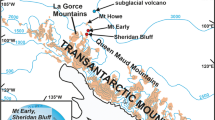Abstract
We present a new model for the evolution of volcanic table mountains, based on volcanological and petrological studies of Herdubreid/Herdubreidartögl, an upper Pleistocene volcanic complex within the active Icelandic rift zone. The evolution of these table mountains is highly complex and influenced substantially by different eruptive environments as well as changing magma sources and volcanic and magmatic processes. Whereas current models imply entirely subglacial conditions and continuous compositional (“monogenetic”) evolution for these volcanoes, we subdivide their evolution into four eruptive periods characterized by different environments: (a) Subaerial lava flows erupted during an interglacial period. (b) Lavas and voluminous hydroclastic deposits formed in a lake during a waning period of the last glaciation. (c) Subglacial eruptions during thickening of the ice sheet as a result of a climatic deterioration built pillow lava piles overlain by steep-sided complexes of hydroclastic deposits. These deposits differ from those of the second eruptive period in structure, texture, and degree of alteration. Subaerial lava flows and agglutinates covered these deposits after buildup above the ice sheet. (d) Subaerial lava flows and fallout deposits during a postglacial period. The detailed analysis of volcanic table mountains appears to be a very sensitive indicator of climatic fluctuations. Although most deposits of the studied volcanoes were formed during the waning period of the last glaciation, the subglacial deposits in the upper part of the volcanic complex reflect a temporary, but major, thickening of the ice sheet.
Similar content being viewed by others
References
Einarsson T (1960) Die Geologie von Hellisheidi (Süd-West-Is-land). Geologisches Institut der Universität Köln Sonderveröffentlichung 5:1–51
Fisher RV, Schmincke H-U (1984) Pyroclastic rocks. Springer, Berlin Heidelberg New York, pp 1–472
Grönvold K (1984) Myvatn fires 1724–1729. Chemical composition of the lava. Nordic Volcanol Inst 8401:1–25
Helz R, Thornber C (1987) Geothermometry of Kilauea Iki lava lake, Hawaii. Bull Volcanol 49:651–668
Hemond C, Arndt N, Lichtenstein U, Hofmann W (1993) The heterogeneous Iceland plume: Nd-Sr-O isotopes and trace element constraints. J Geophys Res 98, No. B9:15.833–15.850
Jakobsson S (1972) On the consolidation and palagonitization of the tephra of the Surtsey volcanic island, Iceland. Surtsey Res Progr Paper 6:121–128
Jakobsson S (1978) Environmental factors controlling the palagonitization of Surtsey tephra, Iceland. Bull Geol Soc Denmark (special issue)) 27:91–105
Jones JG (1969) Intraglacial volcanoes of the Laugarvatn region, south-west Iceland, I. Q J Geol Soc Lond 124:197–211
Jones JG (1970) Intraglacial volcanoes of the Laugarvatn region, south-west Iceland, II. J Geol 78:127–140
Kjartansson G (1943) Arnesingasaga I. Reykjavik, pp 1–268
Metrich N, Clocchiatti C (1989) Melt inclusion investigation of the volatile behaviour in historic alkali basaltic magmas of Etna. Bull Volcanol 51:185–198
Metrich N, Sigurdsson H, Meyer PS, Devine JD (1991) The 1783 Lakagigar eruption in Iceland: geochemistry, CO2 and sulfur degassing. Contrib Mineral Petrol 107:435–447
Moore JG, Calk LC (1991) Degassing and differentiation in subglacial volcanoes, Iceland. J Volcanol Geotherm Res 46:157–180
Moore JG, Schilling J-G (1973) Vesicles, water, and sulfur in Reykjanes Ridge basalts. Contrib Mineral Petrol 41:105–118
Sigvaldason GE, Annertz K, Nilsson M (1992) Effect of glacier loading/deloading on volcanism: postglacial volcanic production rate of the Dyngjufjöll area, central Iceland. Bull Volcanol 54:385–392
Tómasson H (1993) Ice-dammed lakes at Kjölur and catastrophic floods in the Hvìtá river, southern Iceland (in Icelandic). Náttúrufrædingurinn 62 (1–2): 77–98
Werner R (1994) Struktur und Entstehung subglazialer/sublakustrischer Vulkane am Beispiel des Vulkankomplexes Herdubreid/Herdubreidartögl in Island. Ph.D. thesis, University of Kiel, pp 1–154
Author information
Authors and Affiliations
Corresponding author
Rights and permissions
About this article
Cite this article
Werner, R., Schmincke, H.U. & Sigvaldason, G. A new model for the evolution of table mountains: volcanological and petrological evidence from herdubreid and Herdubreidartögl volcanoes (Iceland). Geol Rundsch 85, 390–397 (1996). https://doi.org/10.1007/BF02422244
Received:
Accepted:
Issue Date:
DOI: https://doi.org/10.1007/BF02422244




